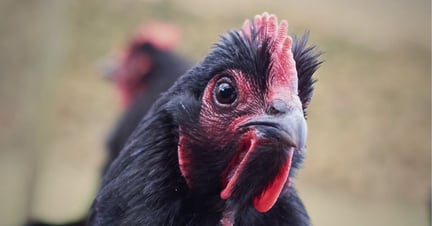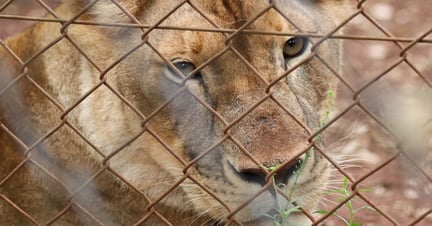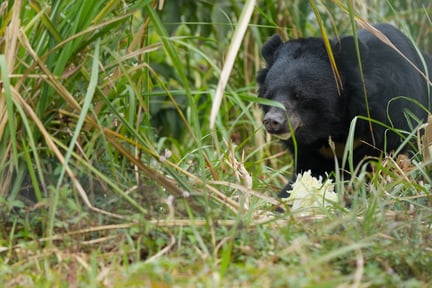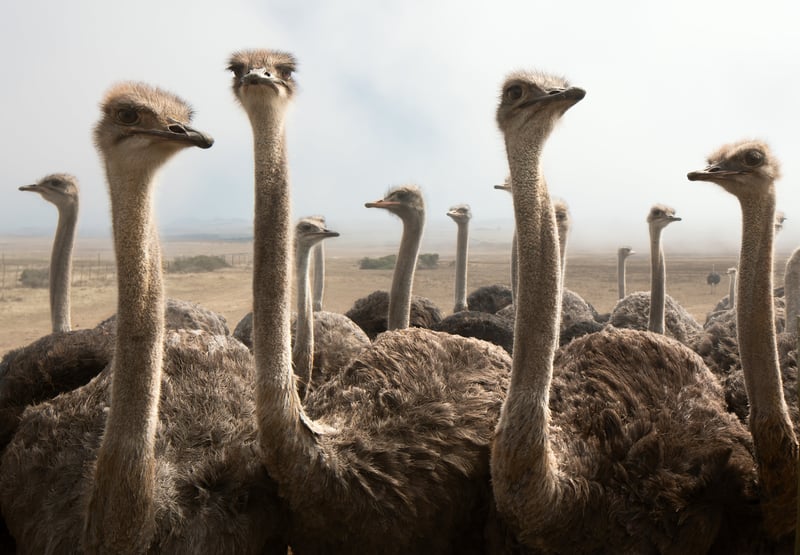
14 interesting facts about ostriches
Blog
The ostrich is the heaviest, largest, and fastest-running bird in the world, though it famously can’t fly. Take a look at the ostrich facts below to learn more about these amazing flightless birds and the cruel ostrich farm trade that threatens their welfare.
With huge bodies, long necks, flowing feathers, and tiny heads, ostriches are distinctive-looking birds found in the African savannah. But not all ostriches get to roam free.
Here, we share some amazing facts about ostriches, covering everything from their diet to their habitat to their behaviour. How fast can an ostrich run? What do ostriches eat? And do ostriches bury their heads? We reveal the truth about these ostrich facts and myths. Plus, we explore the ostrich conservation efforts that are helping to protect them from the fashion industry.
Learn 14 top ostrich facts
1. Ostriches aren't endangered — but they are at risk
We’ll start with the good news: neither the common ostrich nor the Somali ostrich is endangered. According to the IUCN Red List, the former is listed as least concern and the latter as vulnerable.
However, they still face threats from farming, habitat loss, climate change, and hunting, as they are targeted for their meat and eggs. They are also kept in captivity on cruel “feather farms” where they are bred for their feathers and leather, and become innocent victims of the fashion industry.
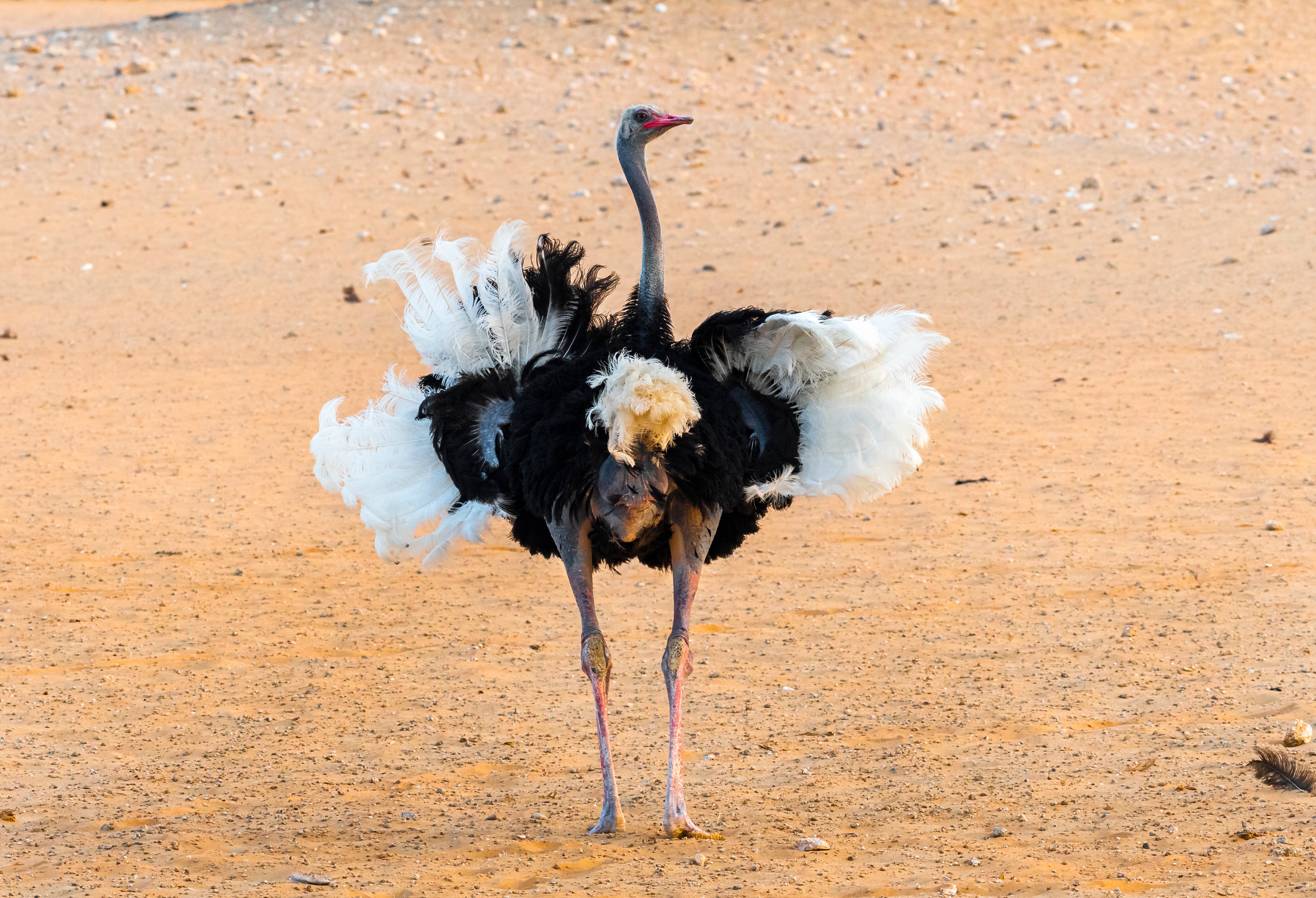
Credit: Ishor gurung/Shutterstock
2. Ostrich eggs are huge
We all know that ostrich eggs are the biggest in the animal kingdom. But how big is an ostrich egg?
Ostrich eggs average 17 to 19 cm in length, 14 to 15 cm in width, and weigh up to 1.9 kg. This compares to just 50 to 70 grams for a hen’s egg, meaning a single ostrich egg is equal to around 25 hen’s eggs.
Another top ostrich fact? While ostrich eggs are the largest of all eggs, they are the smallest eggs relative to the size of the adult bird. An egg weighs less than 1% of the female’s body weight.
3. You can eat ostrich eggs, but really shouldn't
Like many other types of eggs, ostrich eggs are edible. But just because you can eat ostrich eggs doesn’t mean you should.
As with most animal farming, the method used to harvest ostrich eggs isn’t always ethical. It rarely considers the animal’s needs or sentience, instead prioritising the requirements of human food systems over animal welfare.
On farms, ostriches are kept in unnatural conditions with limited space to roam. Chicks are often heartlessly separated from their parents, resulting in severe stress and abnormal behaviours like feather pecking.
Don’t be part of the problem. Instead, favour plant-based meals — and avoid ostrich eggs — to take cruelty off the menu.
4. Ostriches live in Africa
Wild ostriches live on the continent of Africa. The common ostrich is found in the southern Saharan Desert and southern Africa, in Namibia, Zimbabwe, Botswana, and South Africa. The Somali ostrich lives in the Horn of Africa, in Ethiopia, Kenya, Somalia, and Djibouti.
All ostriches roam the savannah looking for food and get most of their water from the plants they eat. They tend to live close to grazing animals, as wildebeest, antelopes, and zebras help to stir up insects and rodents for ostriches to eat. In exchange, ostriches alert the grazers to dangers, helping maintain the balance between predator and prey. Yes, ostriches play a vital role in their ecosystem, and need to be protected!
5. No, ostriches don't bury their heads in the sand at the sight of danger
One of our favourite weird ostrich facts? These birds don’t actually bury their heads in the sand when faced with danger or a predator.
This ostrich behaviour is a myth that originated in ancient Rome. And it has proved so popular that it’s still around today, often used as a metaphor for people who try to avoid their problems.
So, how did the myth come about? There are a lot of theories.
It could be that ostriches look like they’re burying their heads because they have small heads compared to their large bodies. It may be that their heads seem to “disappear” when they get close to the ground.
Alternatively, it could be down to how ostriches care for their eggs. Ostriches don’t build traditional nests. Instead, they dig holes in the sand, lay their eggs there, and then use their beaks to rotate the eggs during incubation. At a distance, this could look like the ostriches are burying their heads in the sand.
One other idea? When faced with danger, ostriches do sometimes flatten themselves to the ground to better blend into their surroundings and make themselves less of a target.

Credit: Emma Chapman/Scott Liffen
6. Ostriches are devoted parents
Both male and female ostriches play a vital role in raising their young, from incubation to hatching to rearing.
First, both parents take turns incubating the eggs, with the female taking the day shift as her brown feathers blend with the landscape and the male taking the night shift as his black feathers are almost undetectable in the dark.
Then, when their chicks have hatched, both male and female ostriches play a role in raising their young. They defend them from predators, provide shelter from the sun and rain with their wings, and guide them to find food.
Though ostrich chicks grow rapidly and reach full size by around 6 months, they often stay with their parents in a protective group during the early months of life. Adult ostriches — especially males — play a key role in defending and guiding the young until they can survive on their own.
7. Ostriches can't fly — but they can run and defend themselves
Like penguins, emus, and kiwis, ostriches can’t fly. Their wings are too small in relation to their bodies, and their breastbone doesn’t anchor the pectoral muscles in the same way as other flying birds.
Though flying may be off the cards, ostriches’ wings do come in useful. They use them for balance and control, particularly while turning, braking, and running, which they can do at incredible speed.
How fast can an ostrich run, we hear you ask? Up to 70 km/h (43 mph), covering 3 to 5 metres in a single stride. They use their speed to escape predators, including lions, leopards, cheetahs, African hunting dogs, and hyenas, and to cover large areas searching for food.
Ostriches are naturally designed to roam free, which is why keeping them confined in farms is so cruel and deprives them of their natural ostrich behaviours.
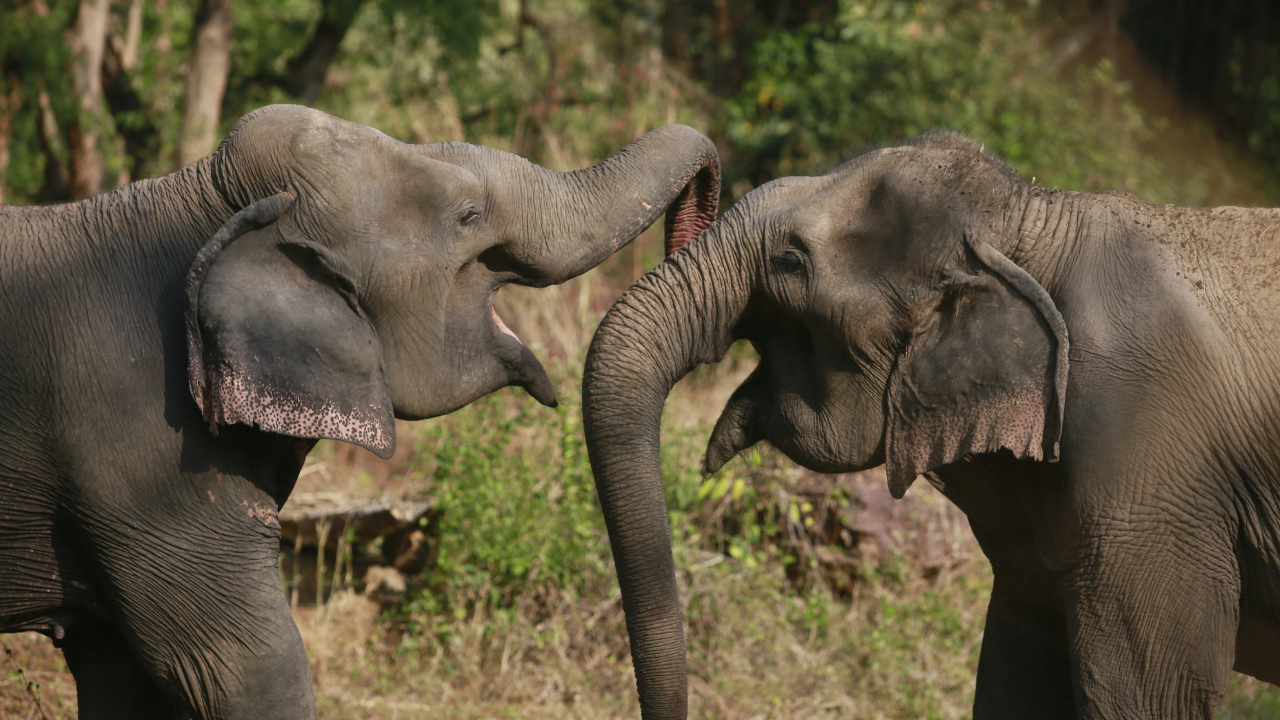
You can make a difference for vulnerable animals
Donate now
When you make a donation, you’ll join a passionate group of supporters who are determined to change the world for animals. We're fighting animal cruelty wherever we find it — are you with us?
Click to donate8. Ostriches’ eyes are larger than their brains
Next on our list of fun facts about ostriches is this surprising one: Ostrich eyes are larger than their brains, which are about the size of a walnut. In fact, they have the largest eyes of any land vertebrate, measuring around 5cm in diameter.
These huge eyes give ostriches sharp, long-distance vision and a wide field of view, great for spotting predators across the open African plains.
9. Ostriches are surprisingly good at navigating in the dark
Another benefit of the ostrich’s large eyes is their ability to see in the dark. Their excellent night vision helps them spot predators throughout the night and navigate in low-light environments.
Interestingly, ostriches don’t sleep through the night. Instead, they have short bursts of sleep so they can remain alert to predators. And — to the human eye — they don’t look like they’re asleep at all. Their heads may droop or sway, but because ostriches keep their eyes open during deep sleep, they look much more alert than they actually are.
Ostriches are clearly highly adapted to their environment, which is a key reason why they struggle so much in captivity. In fact, studies have shown that ostriches in zoos react to visitors as they would to stressors in the wild. With so many people passing by their enclosure, these magnificent birds experience non-stop angst.
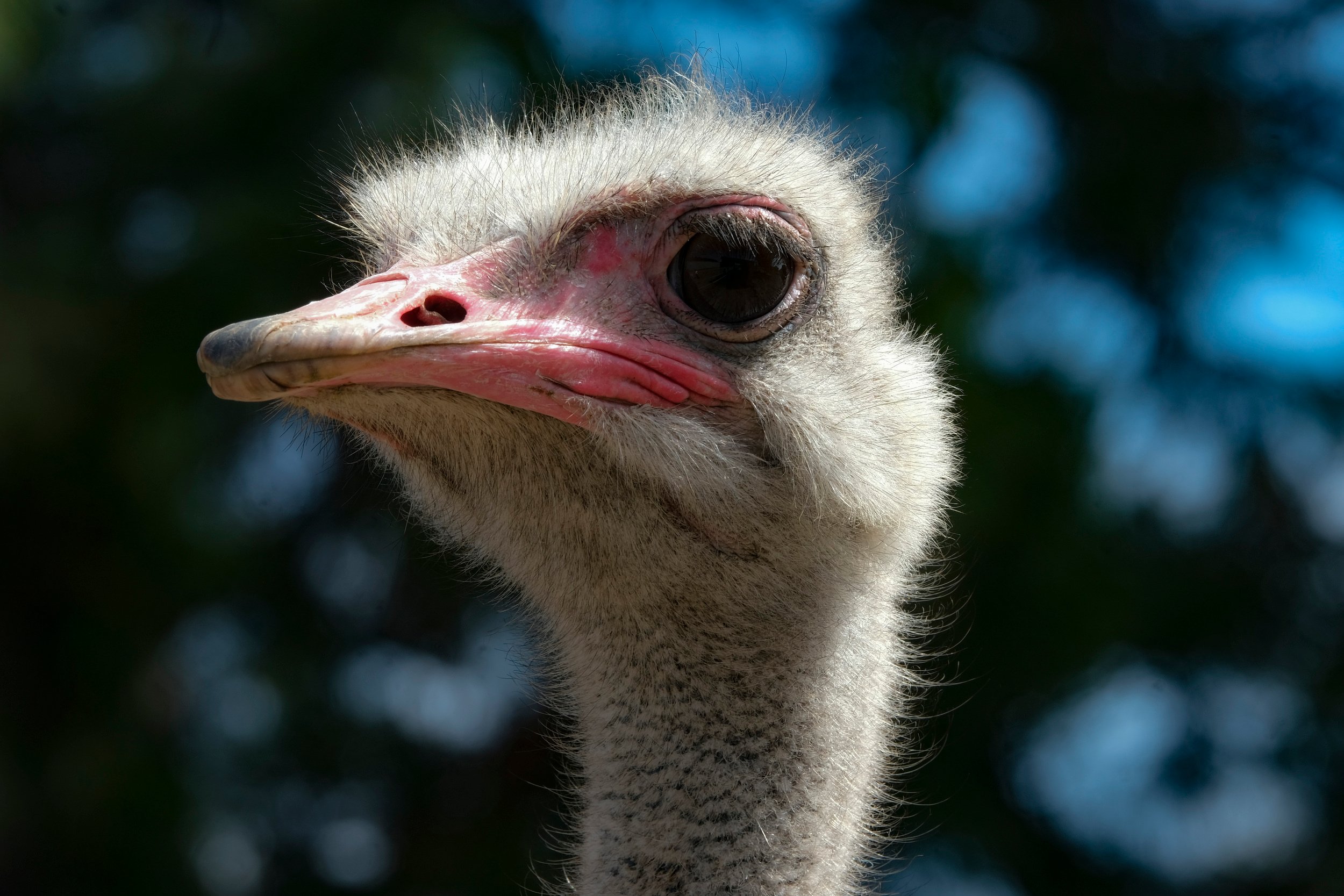
Credit: World Animal Protection / Jodie Grillmeier
9. Ostriches are surprisingly good at navigating in the dark
Another benefit of the ostrich’s large eyes is their ability to see in the dark. Their excellent night vision helps them spot predators throughout the night and navigate in low-light environments.
Interestingly, ostriches don’t sleep through the night. Instead, they have short bursts of sleep so they can remain alert to predators. And — to the human eye — they don’t look like they’re asleep at all. Their heads may droop or sway, but because ostriches keep their eyes open during deep sleep, they look much more alert than they actually are.
Ostriches are clearly highly adapted to their environment, which is a key reason why they struggle so much in captivity. In fact, studies have shown that ostriches in zoos react to visitors as they would to stressors in the wild. With so many people passing by their enclosure, these magnificent birds experience non-stop angst.
10. Farming ostriches raises serious ethical concerns
Time for some not-so-fun facts about ostriches. Every year, tens of thousands of ostriches are confined to barren farms, very different from their natural habitat. Here, they are reared for their feathers and leather, and are brutally live-plucked and slaughtered at as young as nine months.
Life on ostrich farms is full of suffering. It involves cramped spaces, stressful handling, and early slaughter. This depraved environment leads the birds to display unnatural ostrich behaviours, like biting the air, chewing on fences, or pecking at each other’s feathers.
Ostrich leather and feathers may be marketed as luxury items — but the industry depends on sentient animals suffering for the fashion industry's profit.
At World Animal Protection, we’re working to challenge the fashion industry on these practices as part of our ostrich conservation efforts. We’re pushing for cruelty-free materials and wildlife-free fashion weeks.
We’re very happy to see that Melbourne Fashion Week and Australian Fashion Week have gone feather-free in recent years and are pushing for more of the fashion industry to follow suit.
11. Ostriches aren't naturally aggressive but can be defensive
Are ostriches dangerous? They typically prefer to use their long legs and speed to run from danger, rather than standing and fighting. However, when threatened, these birds can deliver a powerful kick capable of killing a human or predator.
Ostriches aren’t vicious by nature, though. They only exhibit this behaviour when cornered, frightened, or provoked, or experiencing high stress in captivity.
12. Ostriches can live for up to 40 years
In the wild, ostriches can live for 30 to 40 years. However, in captivity or on farms, their lives are often, sadly, cut short. They are slaughtered at as young as nine months.
13. Ostriches eat a mainly plant-based diet
Wondering what ostriches eat? These huge birds have a mostly herbivorous diet. In the wild, they graze on seeds, grasses, roots, flowers, shrubs, and fruits. They also eat insects, lizards, and other small creatures, like mice.
They find their food by scavenging and grazing in herds across the African plains, often swallowing stones and pebbles to help grind their food in their gizzard.
In captivity, their diet is very different. Ostriches are often fed on commercial feed. What’s more, farmers are legally allowed to starve these birds and deny them water for up to 24 hours before their slaughter, leaving them hungry and distressed before an agonising death.
14. Ostriches are curious, alert, and complex birds
Ostriches are intelligent, social, and emotionally aware animals. They display problem-solving behaviours and form social bonds within their herds.
But ostriches aren’t naturally friendly towards humans. And they certainly don’t belong on farms or in zoos, and shouldn’t be kept as pets.
These majestic animals deserve our protection and shouldn’t be exploited for entertainment or profit.
Ostriches need our protection, not our exploitation
Ostriches are huge, speedy, and sentient birds with powerful legs. They lay the largest eggs on Earth and take great care of their young.
While ostriches aren’t currently endangered, they face numerous threats at the hands of humans. Ostriches that are farmed — for meat, leather, feathers, and eggs — live unnatural and stressful lives, a far cry from the freedom they enjoy on the African savannah.
That’s why we’re doing all we can to protect ostriches and end their exploitation.
Take a look at all the ways you can support World Animal Protection to defend animals and their rights around the world.


